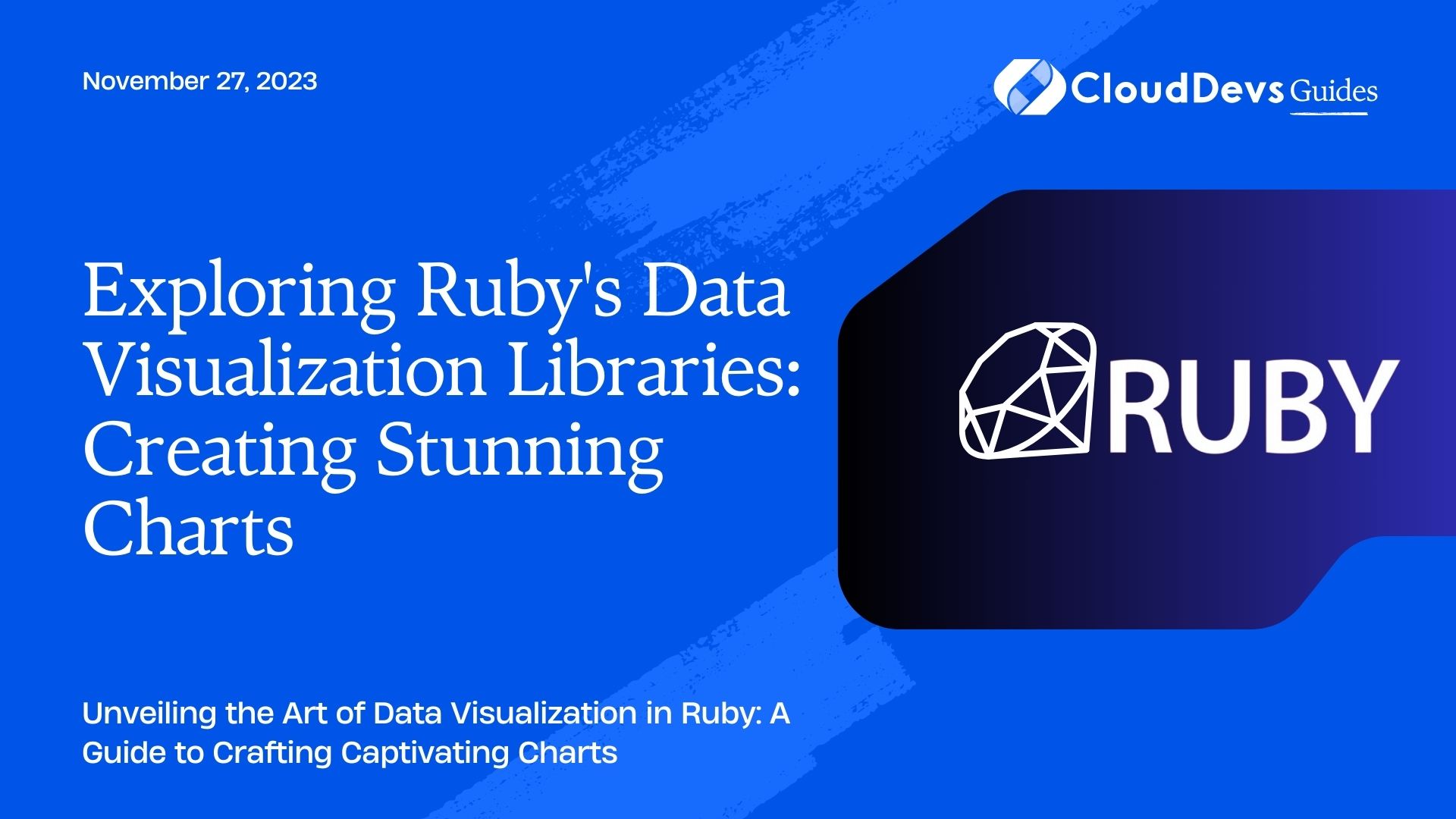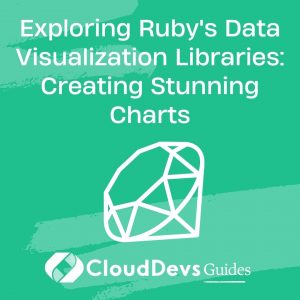Exploring Ruby’s Data Visualization Libraries: Creating Stunning Charts
Data visualization is a crucial aspect of data analysis and presentation. It transforms raw data into a visual format, making it easier to understand and extract insights. Ruby, a versatile and dynamic programming language, offers several data visualization libraries that allow you to create stunning charts and graphs effortlessly. In this blog post, we’ll take a deep dive into some of the most popular Ruby data visualization libraries and learn how to use them to create impressive charts for your projects.
Table of Contents
1. Why Data Visualization Matters
Before we delve into the world of Ruby’s data visualization libraries, let’s briefly discuss why data visualization is so important.
1.1. Data Clarity
Raw data can be overwhelming, especially when dealing with large datasets. Data visualization simplifies complex information, making it more accessible and understandable for a wider audience.
1.2. Pattern Recognition
Visualizing data helps identify patterns, trends, and outliers that might not be apparent in raw data. This can lead to valuable insights and data-driven decisions.
1.3. Communication
Charts and graphs are a universal language. They enable you to convey information effectively to both technical and non-technical stakeholders, facilitating better communication.
Now that we understand the significance of data visualization, let’s explore some of the top Ruby libraries for creating stunning charts.
2. Ruby Data Visualization Libraries
Ruby has a thriving ecosystem of data visualization libraries that cater to various needs and preferences. We’ll focus on three popular ones:
2.1. Gruff
Gruff is a widely used Ruby library for creating simple and aesthetically pleasing graphs. It’s built on top of the Ruby gnuplot library and provides an easy way to generate line graphs, bar charts, and pie charts.
2.1.1. Getting Started with Gruff
To get started with Gruff, you’ll need to install the gem:
ruby gem install gruff
Here’s a quick example of creating a bar chart using Gruff:
ruby
require 'gruff'
g = Gruff::Bar.new
g.title = 'Sample Bar Chart'
g.labels = { 0 => 'Jan', 1 => 'Feb', 2 => 'Mar' }
g.data('Sales', [20, 45, 30])
g.write('bar_chart.png')
In this code, we first create a new bar chart object, set a title, labels, and input data, and then save the chart as an image. Gruff’s simplicity and flexibility make it an excellent choice for quick chart generation.
2.2. LazyHighCharts
LazyHighCharts is a Ruby gem that provides a Ruby-like syntax for creating interactive and responsive charts using the Highcharts JavaScript library. It’s an excellent choice if you need advanced charting capabilities and interactivity.
2.2.1. Getting Started with LazyHighCharts
To use LazyHighCharts, add it to your Gemfile:
ruby gem 'lazy_high_charts'
Here’s an example of creating a simple line chart with LazyHighCharts:
ruby
@chart = LazyHighCharts::HighChart.new('graph') do |f|
f.title(text: 'Sample Line Chart')
f.xAxis(categories: ['Jan', 'Feb', 'Mar'])
f.series(name: 'Sales', data: [20, 45, 30])
end
In this code, we create a HighChart object, set a title, define x-axis categories, and specify the series data. LazyHighCharts seamlessly integrates with Ruby and Highcharts, allowing you to build interactive charts with ease.
2.3. Plotly
Plotly is a versatile data visualization library that supports multiple programming languages, including Ruby. It offers interactive charts, dashboards, and even 3D visualizations. Plotly can be an excellent choice for data scientists and developers who need powerful and customizable visuals.
2.3.1. Getting Started with Plotly
To use Plotly in Ruby, you can install the plotly gem:
ruby gem install plotly
Here’s an example of creating a basic scatter plot using Plotly in Ruby:
ruby
require 'plotly'
Plotly::Plot.new(
data: [{ x: [1, 2, 3, 4], y: [10, 11, 12, 13], mode: :markers, type: :scatter }],
layout: { title: 'Sample Scatter Plot' }
).show
In this code, we define data as an array of traces, with each trace specifying the x and y values. The layout section allows you to set the chart’s title. Plotly provides extensive customization options for creating complex and interactive charts.
3. Choosing the Right Library
Now that you’re familiar with these Ruby data visualization libraries, you might wonder which one is the best choice for your project. Here are some factors to consider when making your decision:
3.1. Complexity of Visualization
If you need simple and straightforward charts for basic data representation, Gruff is an excellent choice due to its ease of use. However, if you require advanced and interactive visuals, LazyHighCharts and Plotly offer more features.
3.2. Interactivity
LazyHighCharts and Plotly shine when it comes to creating interactive charts that allow users to explore and interact with the data. If interactivity is a priority, these libraries are your go-to options.
3.3. Integration
Consider the tools and technologies you’re already using in your project. If you’re working with JavaScript and want a seamless integration between Ruby and JavaScript, LazyHighCharts or Plotly (which is JavaScript-based) might be preferable.
3.4. Community and Support
Check the community and support for each library. Gruff and LazyHighCharts have been around for a while and have established user communities. Plotly, being a multi-language library, also has strong community support.
3.5. Customization
If you need highly customized and unique chart designs, LazyHighCharts and Plotly provide more extensive customization options, including theming and 3D visualizations.
3.6. Performance
Consider the performance requirements of your project. Gruff may perform better for simple charts due to its lightweight nature, while Plotly’s complex visualizations may have slightly higher overhead.
4. Best Practices for Data Visualization in Ruby
Regardless of the library you choose, there are some best practices to keep in mind when creating data visualizations in Ruby:
4.1. Understand Your Data
Before creating a chart, thoroughly understand your data and the story you want to tell with it. Consider the type of data (numeric, categorical, time series) and choose the appropriate chart type.
4.2. Keep it Simple
Avoid cluttering your charts with too much information. Use colors, labels, and legends sparingly to enhance readability.
4.3. Label and Annotate
Always label your axes and data points. Annotations and captions can provide context and clarity to your visualizations.
4.4. Consistency in Styling
If you’re creating multiple charts in your project, maintain consistency in styling, such as colors, fonts, and chart sizes, to create a cohesive visual identity.
4.5. Responsive Design
Ensure your charts are responsive and adapt to different screen sizes and devices. LazyHighCharts and Plotly are well-suited for creating responsive visualizations.
4.6. Accessibility
Consider accessibility guidelines when creating charts to ensure they are usable by individuals with disabilities. Provide alternative text for images and use high-contrast colors.
Conclusion
Data visualization is a powerful tool for making sense of complex data and communicating insights effectively. Ruby, with its versatile ecosystem of data visualization libraries, allows you to create stunning charts and graphs for your projects.
Whether you choose Gruff for simplicity, LazyHighCharts for interactivity, or Plotly for advanced customization, you have the tools to elevate your data presentation game in Ruby.
Remember that effective data visualization goes beyond choosing the right library; it involves understanding your data, adhering to best practices, and tailoring your visuals to your audience’s needs. So, explore these libraries, experiment, and craft data-driven narratives that captivate and inform your audience. Happy charting!
Table of Contents








